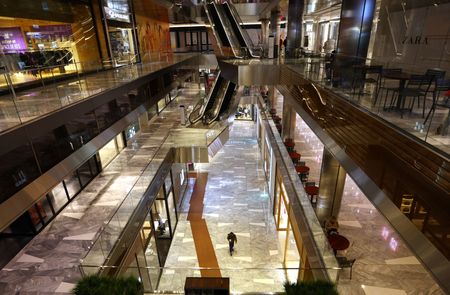By Lucia Mutikani
WASHINGTON (Reuters) – U.S. consumer spending appears to have increased solidly in April, with households boosting purchases at online retailers as well as spending more at restaurants and bars, signs of resilience in the face of growing headwinds to the economy.
The economy’s improving fortunes were further bolstered by other data on Tuesday showing production at factories surged last month. Homebuilder sentiment also increased to a 10-month high in May. The data added to strong job growth in April in suggesting that the economy was experiencing a revival after activity slowed in February and March.
Spending is being underpinned by strong wage gains resulting from a tight labor market, though high inflation and rises in interest rates are causing consumers to be more selective and price conscious.
Most economists expect consumer spending will support the economy despite rising risks of a recession as the cumulative and delayed effects of the Federal Reserve’s fastest monetary policy tightening campaign since the 1980s start to broaden out. The data did not change economists’ expectations that the U.S. central bank will stop hiking interest rates next month.
“Today’s report should help reassure markets that consumer spending is not about to contract and will instead support at least modest continued economic growth,” said Andrew Hollenhorst, chief U.S. economist at Citigroup in New York.
Retail sales excluding automobiles, gasoline, building materials and food services rebounded 0.7% last month, the Commerce Department said. Data for March was revised slightly down to show these so-called core retail sales slipping 0.4% instead of 0.3% as previously reported.
Economists polled by Reuters had forecast core retail sales would gain 0.3%. Core retail sales correspond most closely with the consumer spending component of gross domestic product.
Economists estimated that core retail sales adjusted for inflation rose by about 0.6% in April. These so-called real core sales were weak in the prior two months.
“Outright declines in spending will be needed in the remaining two months of the second quarter to spur a contraction in real personal consumption,” said Sal Guatieri, a senior economist at BMO Capital Markets in Toronto. “This risks another delay in the long-awaited recession, likely due to ongoing revenge spending, excess savings, and sturdy income growth.”
Consumer spending, which accounts for more than two-thirds of U.S. economic activity, accelerated in the first quarter, offsetting the drag on GDP growth from an inventory liquidation.
The economy grew at a 1.1% annualized rate last quarter. Goldman Sachs lifted its second-quarter GDP growth tracking estimate by two-tenths of a percentage point to a 2.0% pace.
Stocks on Wall Street were trading mostly lower. The dollar rose against a basket of currencies. U.S. Treasury prices fell.
MORE DINING, DRINKING
Overall retail sales rose 0.4% last month, missing economists’ expectations for a 0.8% increase, after dropping 0.7% in March. Retail sales are mostly goods and are not adjusted for inflation. The smaller-than-expected rebound likely reflected a moderate rise in receipts at auto dealerships, which some economists said was because of lower prices. Automobile manufacturers reported a surge in unit sales in April.
Sales at auto dealers rose 0.4% after back-to-back declines.
Online retail sales surged 1.2%, likely as price-conscious consumers continue to seek discounts and deals. Sales at food services and drinking places, the only services category in the retail sales report, rose 0.6%. Economists view dining out as a key indicator of household finances. Consumers stepped up purchases at health and personal care stores.
Sales at building material and garden equipment supplies dealers increased 0.5%, aligning with an improvement in the depressed housing market.
A survey on Tuesday showed the National Association of Home Builders/Wells Fargo Housing Market index increased five points to a reading of 50 this month, the fifth straight monthly increase. That rise lifted the index to the midpoint mark of 50 for the first time since July 2022.
But the housing market is not out of the woods yet amid higher mortgage rates. Home Depot, the nation’s largest home improvement chain, on Tuesday cut its annual sales forecast and projected a steeper-than-expected drop in profit.
Even as consumers remain resilient, they are also showing some fatigue as inflation gradually slows, forcing cuts in purchases of some big-ticket items as well discretionary spending.
Furniture store sales fell 0.7% while receipts at electronics and appliance stores dropped 0.5%. Spending on hobbies decreased 3.3%. Sales at service stations fell 0.8%.
“This suggests Americans cut back on discretionary Easter and spring break travel,” said Bill Adams, chief economist at Comerica Bank in Dallas.
A separate report from the Fed showed manufacturing output jumped 1.0% last month after dropping 0.8% in March.
It was boosted by a 9.3% acceleration in motor vehicle production as supply chain log-jams finally resolve. There were also gains in the output of other long-lasting manufactured goods as well as nondurable products.
Though manufacturing, which accounts for 11.3% of the U.S. economy, is being hamstrung by higher borrowing costs, economists said the sector was benefiting from not over-producing heading into a downturn.
“That approach is now paying off,” said Tim Quinlan, a senior economist at Wells Fargo in Charlotte, North Carolina. “When demand picks back up, rather than having to draw down inventory, firms that did not overproduce can increase output instead.”
(Reporting by Lucia Mutikani; Editing by Chizu Nomiyama and Paul Simao)





